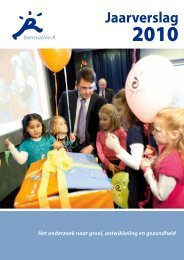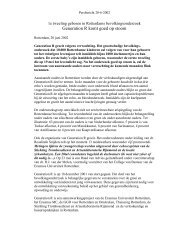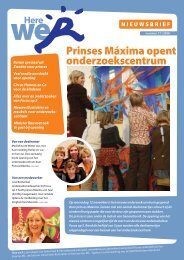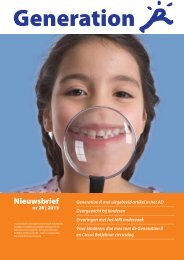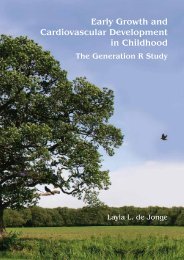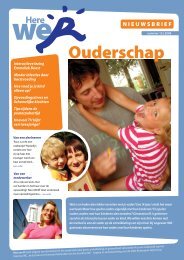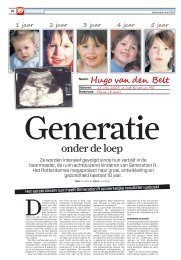Parents and infants: determinants of attachment in a ... - Generation R
Parents and infants: determinants of attachment in a ... - Generation R
Parents and infants: determinants of attachment in a ... - Generation R
Create successful ePaper yourself
Turn your PDF publications into a flip-book with our unique Google optimized e-Paper software.
Attachment, depression, <strong>and</strong> cortisol: Deviant patterns <strong>in</strong> <strong>in</strong>secure-resistant <strong>and</strong> disorganized <strong><strong>in</strong>fants</strong><br />
showed a significant association between maternal depression <strong>and</strong> <strong>attachment</strong><br />
<strong>in</strong>security (e.g. Teti, Gelf<strong>and</strong>, Mess<strong>in</strong>ger, & Isabella, 1995). In community-based<br />
samples, however, the effect <strong>of</strong> maternal depressive symptoms<br />
on <strong>attachment</strong> quality is less clear; meta-analyses reported small or even<br />
<strong>in</strong>significant effect sizes (Atk<strong>in</strong>son et al., 2000; Van IJzendoorn, Schuengel<br />
& Bakermans-Kranenburg, 1999). Other studies suggested that pre- <strong>and</strong><br />
postnatal depression might <strong>in</strong>fluence mother-child <strong>in</strong>teraction (Lundy et al.,<br />
1999; Righetti-Veltema, Bousquet & Manzano, 2003).<br />
In the current study we exam<strong>in</strong>e both cortisol reactivity to a stressor<br />
<strong>and</strong> the diurnal rhythm <strong>of</strong> cortisol <strong>in</strong> relation to <strong><strong>in</strong>fants</strong>’ <strong>attachment</strong> status.<br />
We expect higher stress reactivity <strong>in</strong> <strong>in</strong>securely attached children than<br />
<strong>in</strong> securely attached children. Furthermore, we expect that <strong><strong>in</strong>fants</strong> <strong>in</strong> the<br />
disorganized group differ <strong>in</strong> their cortisol reactivity from non-disorganized<br />
<strong><strong>in</strong>fants</strong>. With respect to diurnal rhythm, we expect to f<strong>in</strong>d a general pattern<br />
with higher morn<strong>in</strong>g than even<strong>in</strong>g cortisol values. S<strong>in</strong>ce this study is the first<br />
to explore cortisol diurnal rhythm <strong>in</strong> relation to <strong>in</strong>fant <strong>attachment</strong> status,<br />
we have no directed hypothesis on differences among <strong>attachment</strong> groups.<br />
Furthermore, we exam<strong>in</strong>e the moderat<strong>in</strong>g role <strong>of</strong> maternal depression on<br />
the association between <strong>attachment</strong> quality <strong>and</strong> cortisol levels. As maternal<br />
depression is related to <strong>in</strong>secure <strong>in</strong>fant <strong>attachment</strong> <strong>and</strong> sub-optimal cortisol<br />
outcomes, maternal depression is hypothesized to act as an additional risk<br />
factor <strong>in</strong> the relation between <strong>in</strong>secure <strong>attachment</strong> <strong>and</strong> cortisol.<br />
Method<br />
Sett<strong>in</strong>g<br />
The current <strong>in</strong>vestigation is embedded with<strong>in</strong> the <strong>Generation</strong> R Study,<br />
a prospective cohort study <strong>in</strong>vestigat<strong>in</strong>g growth, development <strong>and</strong> health<br />
from fetal life <strong>in</strong>to young adulthood <strong>in</strong> Rotterdam, the Netherl<strong>and</strong>s, which<br />
has been described <strong>in</strong> detail elsewhere (Jaddoe et al., 2007; 2008). In the<br />
<strong>Generation</strong> R Study, we obta<strong>in</strong>ed detailed measurements <strong>of</strong> the child’s development<br />
<strong>in</strong> a rather homogeneous subgroup: The <strong>Generation</strong> R Focus Study.<br />
Only children <strong>of</strong> Dutch national orig<strong>in</strong> were <strong>in</strong>cluded <strong>in</strong> this group, mean<strong>in</strong>g<br />
that the children, their parents <strong>and</strong> their gr<strong>and</strong>parents were all born <strong>in</strong> the<br />
Netherl<strong>and</strong>s. The participat<strong>in</strong>g children were born between February 2003<br />
<strong>and</strong> August 2005. The children visited the research center regularly for<br />
various somatic <strong>and</strong> behavioral assessments. Written <strong>in</strong>formed consent was<br />
obta<strong>in</strong>ed from all participants. The study has been approved by the Medical<br />
Ethical Committee <strong>of</strong> the Erasmus Medical Center, Rotterdam.<br />
<br />
89




